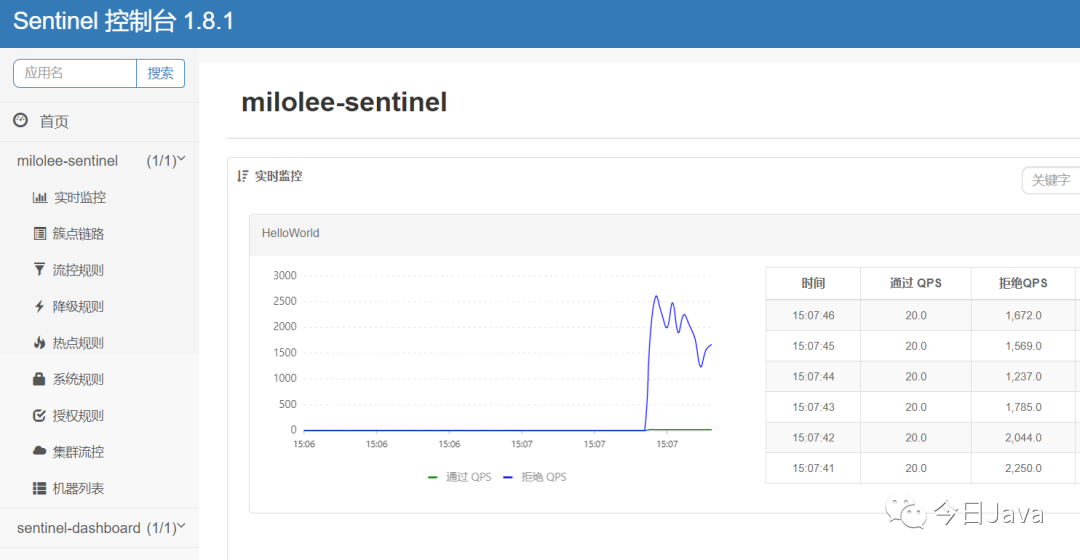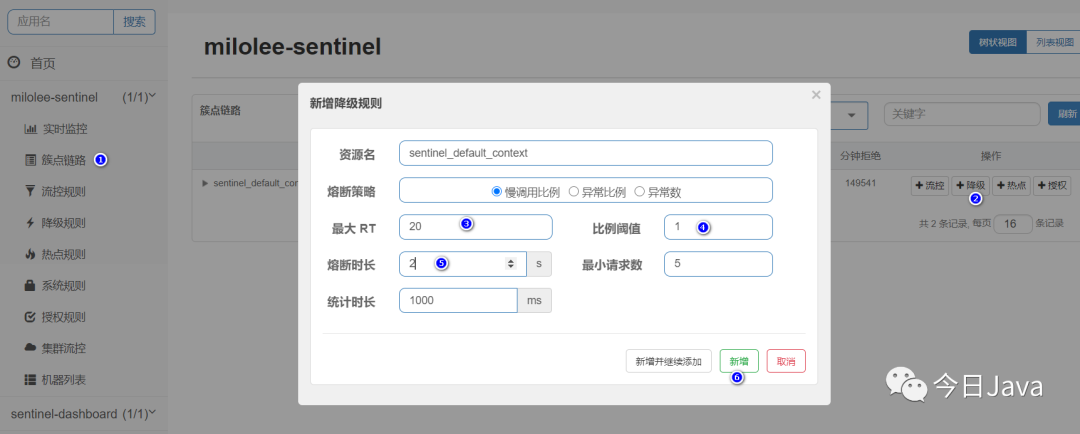
Sentinel控制台搭建
Sentinel 客户端
项目搭建
如何定义资源
启动控制台
控制台配置规则
Hello,大家好,我是麦洛,今天带大家来了解一下SpringBoot如何继承Sentinel来实现接口流量控制
假如大家有什么问题或者建议,可以关注公众号,回复"加群"就可以获取到我的个人微信二维码,可以拉大家进交流群一起讨论学习;
Sentinel控制台搭建
在我的上一篇文章阿里出品的Sentinel到底是个什么玩意?中,已经介绍过如何准备Sentinel控制台,大家可以直接参考;
Sentinel 客户端
项目搭建
首先我们来创建一个测试项目,这里初始化项目的url建议大家填写阿里云的地址,会有惊喜????
http://start.aliyun.com

接下来就是常规操作,一路next,在下图的位置稍微注意一下

说明:
同大家以前创建项目一样,只需要在这里勾选Sentinel就可以啦????
项目创建好以后,我们发现pom文件中引入了下面的依赖

有的小伙伴看网上博客,也会有下面的方式,指定版本号
<!-- sentinel -->
<dependency>
<groupId>com.alibaba.cloud</groupId>
<artifactId>spring-cloud-starter-alibaba-sentinel</artifactId>
<version>2.1.0.RELEASE</version>
</dependency>
如果你使用我推荐的阿里云的Url,会发现Sentinel的版本号都定义父工程,Cloud的各个组件的兼容性就不要大家操心了
<dependencyManagement>
<dependencies>
<dependency>
<groupId>org.springframework.boot</groupId>
<artifactId>spring-boot-dependencies</artifactId>
<version>${spring-boot.version}</version>
<type>pom</type>
<scope>import</scope>
</dependency>
<dependency>
<groupId>com.alibaba.cloud</groupId>
<artifactId>spring-cloud-alibaba-dependencies</artifactId>
<version>${spring-cloud-alibaba.version}</version>
<type>pom</type>
<scope>import</scope>
</dependency>
</dependencies>
</dependencyManagement>
打开项目配置文件,会发现它已经为我们自动加好了配置,真的超级方便????
server.port=8083
# 应用名称
spring.application.name=springcloud-sentinel
# Sentinel 控制台地址
spring.cloud.sentinel.transport.dashboard=localhost:8080
# 取消Sentinel控制台懒加载
# 默认情况下 Sentinel 会在客户端首次调用的时候进行初始化,开始向控制台发送心跳包
# 配置 sentinel.eager=true 时,取消Sentinel控制台懒加载功能
spring.cloud.sentinel.eager=true
# 如果有多套网络,又无法正确获取本机IP,则需要使用下面的参数设置当前机器可被外部访问的IP地址,供admin控制台使用
# spring.cloud.sentinel.transport.client-ip=# sentinel 配置
spring.application.name=frms
spring.cloud.sentinel.transport.dashboard=localhost:8080
spring.cloud.sentinel.transport.heartbeat-interval-ms=500
如何定义资源
编程式定义
官网提供的demo
package com.milo.sentinel;
import com.alibaba.csp.sentinel.Entry;
import com.alibaba.csp.sentinel.SphU;
import com.alibaba.csp.sentinel.slots.block.BlockException;
import com.alibaba.csp.sentinel.slots.block.RuleConstant;
import com.alibaba.csp.sentinel.slots.block.flow.FlowRule;
import com.alibaba.csp.sentinel.slots.block.flow.FlowRuleManager;
import org.springframework.boot.SpringApplication;
import org.springframework.boot.autoconfigure.SpringBootApplication;
import java.util.ArrayList;
import java.util.List;
/**
* 项目入口
* @author Milo Lee
* @date 2021-3-20 19:07
*
*/
@SpringBootApplication
public class SentinelApplication {
public static void main(String[] args) {
SpringApplication.run(SentinelApplication.class, args);
// 配置规则.
initFlowRules();
while (true) {
// 1.5.0 版本开始可以直接利用 try-with-resources 特性
try (Entry entry = SphU.entry("HelloWorld")) {
// 被保护的逻辑
Thread.sleep(300);
System.out.println("hello world");
} catch (BlockException | InterruptedException ex) {
// 处理被流控的逻辑
System.out.println("blocked!");
}
}
}
private static void initFlowRules(){
List<FlowRule> rules = new ArrayList<>();
FlowRule rule = new FlowRule();
rule.setResource("HelloWorld");
rule.setGrade(RuleConstant.FLOW_GRADE_QPS);
// Set limit QPS to 20.
rule.setCount(20);
rules.add(rule);
FlowRuleManager.loadRules(rules);
}
}
注解式定义
@SpringBootApplication
public class Application {
public static void main(String[] args) {
SpringApplication.run(ServiceApplication.class, args);
}
}
@Service
public class TestService {
@SentinelResource(value = "sayHello")
public String sayHello(String name) {
return "Hello, " + name;
}
}
@RestController
public class TestController {
@Autowired
private TestService service;
@GetMapping(value = "/hello/{name}")
public String apiHello(@PathVariable String name) {
return service.sayHello(name);
}
}
@SentinelResource 注解用来标识资源是否被限流、降级。上述例子上该注解的属性 sayHello 表示资源名。
启动控制台
java -Dserver.port=8080 -Dcsp.sentinel.dashboard.server=localhost:8080 -Dproject.name=sentinel-dashboard -jar sentinel-dashboard-1.8.1.jar

控制台配置规则
控制台的操作我们用编程式定义的例子来演示,大家启动我们的服务

我们会发现除了sentinel-dashboard之外,多了一个milolee-sentinel,这个就是我们的服务,它的名称其实对应我们配置文件定义的应用名称:
# 应用名称
spring.application.name=milolee-sentinel
点击机器列表,这这里如果能发现你的机器,那就是成功上线了

实时监控

簇点链路

流控规则配置
给我们的资源HelloWorld配置流控规则,它的QPS(每秒请求数)为1,如图:

通过查看实时监控,我们发现已经生效

降级规则配置
给我们的资源HelloWorld添加一个降级规则配置,如果QPS大于1,且平均响应时间大于20ms,则接口下来接口在2秒钟无法访问,之后自动恢复。

目前这些规则仅在内存态生效,应用重启之后,该规则会丢失。后续文章我们会继续学习动态规则

????关于控制台的使用,大家可以参考官方文档,比较详细https://sentinelguard.io/zh-cn/docs/dashboard.html
好了,今天就分享到这里,感谢你的阅读。

如果喜欢,求点赞、在看、转发!
推荐阅读
离职后,10天面试 4 家公司的总结
一套Spring Cloud Alibaba视频教程
后端开发人员,学习之路
美团面试:接口被恶意狂刷,怎么办?
112期面试汇总,建议收藏
最后
以上就是害怕画板最近收集整理的关于面试官:Sentinel如何实现接口流量控制?的全部内容,更多相关面试官:Sentinel如何实现接口流量控制内容请搜索靠谱客的其他文章。








发表评论 取消回复